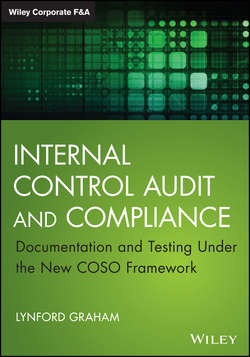Читать книгу Internal Control Audit and Compliance - Graham Lynford - Страница 14
На сайте Литреса книга снята с продажи.
Chapter 1
What We All Share
Triangle of Efficiency
ОглавлениеEveryone desires an efficient project. From experience, an important consideration in achieving an efficient implementation of a controls assessment project is an understanding of the tasks and the acquisition of the skills before beginning in earnest the documentation, assessment, and testing process. Time and again the failure of one of the three key elements in what I call the triangle of efficiency (see Figure 1.3) is the root cause of wasted time and energy, and more often than not it results in an incomplete or incorrect assessment. This is an issue worth mentioning at the start, because false steps will cost money to correct.
Figure 1.3 Triangle of Efficiency
The three knowledge components are:
1. Knowledge of entity and/or auditor requirements.
2. Knowledge of COSO.
3. Knowledge of company controls and processes.
In the case of public companies, their specific requirements are stated by the SEC. Private companies should look to COSO for guidance. While there is nothing contradictory about the SEC and COSO literatures, public companies should be familiar with the SEC-specific requirements, which may contain more detail regarding specific reporting and filing requirements. Public company auditors will be looking toward PCAOB Auditing Standard No. 5 for their requirements, which happen to be closely aligned with the SEC requirements, and ensuring public companies are following that guidance.
It often feels good just to get started on a project and begin to accumulate some evidence of progress. Indeed, that was a clear motivation in companies and auditors beginning to document the detailed activity-level controls over transactions before comprehending the scope of the requirements in 2004 when first reporting on controls under SOX. The resultant complaints about costs and time expended are intertwined with issues regarding failures to consider one or more of the three triangle components.
Experience says that if any of the three elements here is lacking, then there will be an impact on the efficiency and effectiveness of the overall project. Company consultants may be very competent in knowing COSO and knowing company and audit requirements, but they still have to learn the entity and its controls in order to perform their task. Close integration of company and consulting personnel can contribute greatly to efficiency of the company project over a strategy where the task is given primarily to the consultant. In the long run, the most efficient process is often one that is brought in-house and maintained by the entity. This controls focus in entity culture and auditing is not likely to go away. It is likely a part of our permanent business environment.
